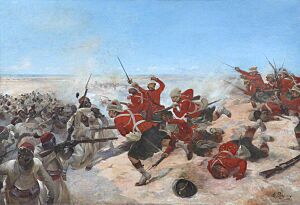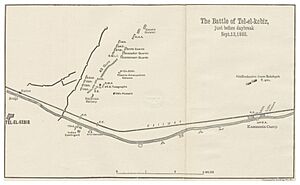Battle of Tell El Kebir facts for kids
Quick facts for kids Battle of Tel El Kebir |
|||||||
|---|---|---|---|---|---|---|---|
| Part of Anglo-Egyptian War | |||||||
 The Storming of Tel el Kebir Alphonse de Neuville, 1883 |
|||||||
|
|||||||
| Belligerents | |||||||
| Commanders and leaders | |||||||
| Strength | |||||||
| 13,000 troops 60 guns |
18,000 troops (estimates) 60–75 guns |
||||||
| Casualties and losses | |||||||
| 57 killed 380 wounded 22 missing |
2,000 killed 58 guns captured |
||||||
The Battle of Tel El Kebir was a very important fight that happened in Egypt on September 13, 1882. It took place near a place called Tell El Kebir, about 110 kilometers (68 miles) northeast of Cairo. In this battle, a British army, led by General Garnet Wolseley, surprised and defeated an Egyptian army. The Egyptian forces were commanded by Ahmed ʻUrabi and had built strong defenses. This battle was a key moment in the Anglo-Egyptian War.
Contents
Why the Battle Happened
Trouble in Alexandria: A City Under Fire
In May 1882, ships from both France and Britain arrived in Alexandria, a big city in Egypt. At the same time, Egyptian soldiers were making their city's defenses stronger, expecting a fight. This made everyone in Alexandria very nervous. Soon, there were big riots where people from both sides were hurt or killed.
Because of these riots, the British and French sent a message to the Egyptian government. They demanded that Egyptian officers in Alexandria remove their coastal cannons. But the Egyptian government said no. Britain and France also had disagreements about what to do next. France decided not to send its army to help.
When the Egyptians did not follow the demand, a British Admiral named Seymour ordered his navy to attack. On July 11, at 7:00 AM, British warships began firing at the Egyptian defenses in Alexandria. The Egyptian cannons fired back, but they didn't do much damage to the British ships. No British ships sank. Two days later, on July 13, many British sailors landed in the city. Even though the Egyptian soldiers fought hard, the British had much stronger weapons. This forced the Egyptian troops to leave Alexandria.
Getting Ready for Battle
General Garnet Wolseley was put in charge of a large British army. His goal was to stop Urabi's government and bring back the power of the Khedive Tawfiq, who was the ruler of Egypt. Wolseley's army had about 24,000 British soldiers and 7,000 soldiers from India.
Wolseley first tried to march his army directly to Cairo from Alexandria. But Urabi had placed his troops at Kafr El Dawwar and built very strong defenses. The British tried to attack there for five weeks but were pushed back in the Battle of Kafr El Dawwar.
Taking Control of the Suez Canal
Wolseley then decided to try a different way to reach Cairo. He planned to attack from the direction of the Suez Canal. Urabi knew this was another possible route and wanted to block it. However, Ferdinand de Lesseps, who helped build the canal, told Urabi that the British would never risk damaging the canal. He even promised Urabi that the British would not land troops there. Urabi trusted de Lesseps, which turned out to be a big mistake. He left the canal open, allowing the British to use it.
When Wolseley arrived in Alexandria on August 15, he quickly moved his troops through the Suez Canal to Ismaïlia. They did this so fast that Ismaïlia was taken without any fighting on August 20.
Ismaïlia quickly received 9,000 more troops. Engineers worked hard to fix the railway line from Suez. A smaller group of soldiers moved along the Sweet Water Canal and reached a place called Kassassin on August 26.
Egyptian Attacks at Kassassin
Urabi tried to stop the British advance by attacking their forces near Kassassin on August 28. The British soldiers were surprised because they didn't expect an attack. The fighting was tough, but two British battalions, with their four cannons, managed to hold their ground.
British cavalry, including the Household Cavalry, arrived and joined the fight. They pushed the Egyptian forces back about 5 kilometers (3 miles), causing many casualties.
Another attack by Egyptian forces at Kassassin was also stopped. The Egyptians then went back to their lines to build more defenses.
A Key Capture: General Mahmoud Fehmy
Around the same time as the first battle at Kassassin, the British had an important success. They captured General Mahmoud Fehmy, who was Egypt's chief military engineer. It's not fully clear how he was captured. One story says he was walking in civilian clothes when British cavalry soldiers ambushed him. Losing General Fehmy was a big problem for the Egyptian defenses at Tel El Kebir. He was a very respected general who had just arrived to help build the fortifications.
The Main Battle at Tel El Kebir
Urabi had moved his army to defend Cairo from Wolseley. His main forces dug in at Tel El Kebir. This area was north of the railway and the Sweetwater Canal, which both connected Cairo to Ismailia. The Egyptian defenses were built quickly. They included trenches and small forts. Urabi's army had 60 cannons and modern rifles.
General Wolseley secretly checked the Egyptian defenses several times. He noticed that the Egyptians did not guard the areas in front of their main defenses at night. This meant an attacking army could get close in the dark without being seen. Instead of trying to go around the defenses or attacking openly, Wolseley planned a surprise night march. He would attack the front of the Egyptian position at dawn.
Wolseley started his advance from Ismailia on the night of September 12. He had two groups of infantry soldiers and a cavalry group. A group of Indian soldiers protected the side of the army along the Sweetwater Canal. The march was easier because the desert west of Kassassin was very flat. It looked like a giant parade ground. Even with stops to keep everyone in line, the British troops reached the Egyptian position exactly when Wolseley planned.
At 5:45 AM, Wolseley's troops were about 550 meters (600 yards) from the trenches. Dawn was just breaking when Egyptian guards spotted them and fired. Many shots and cannon fire followed from the Egyptian defenses. British troops, led by the Highland Brigade and the 2nd Brigade, charged forward with their bayonets. The Guards Brigade, commanded by Prince Arthur, Queen Victoria's son, supported them.
Smoke from the Egyptian cannons and rifles helped hide the British advance. The British soldiers reached the trenches all along the line at the same time. The battle was over in less than an hour. Most Egyptian soldiers were tired because they had been on alert all night. Also, because Urabi's forces built their defenses so quickly, there were no obstacles in front of them to slow down the attackers. Some groups, especially Sudanese soldiers, fought bravely against the British Blackwatch Regiment. But most Egyptian soldiers were forced to retreat.
It was a huge defeat for the Egyptians. Official British records show 57 British soldiers were killed. About 2,000 Egyptian soldiers died. The British army actually had more soldiers get sick from heatstroke than from enemy attacks.
British cavalry chased the defeated Egyptian army towards Cairo, which was now unprotected. The Khedive was put back in power, and the war ended. Most of the British Army sailed home from Alexandria. Only a small group remained in Egypt to keep order starting in November.
Lieutenant William Mordaunt Marsh Edwards was awarded a Victoria Cross for his bravery during the battle.
See also




